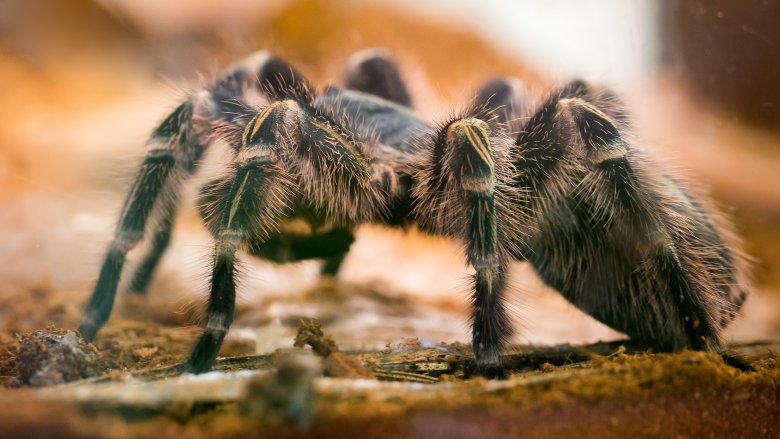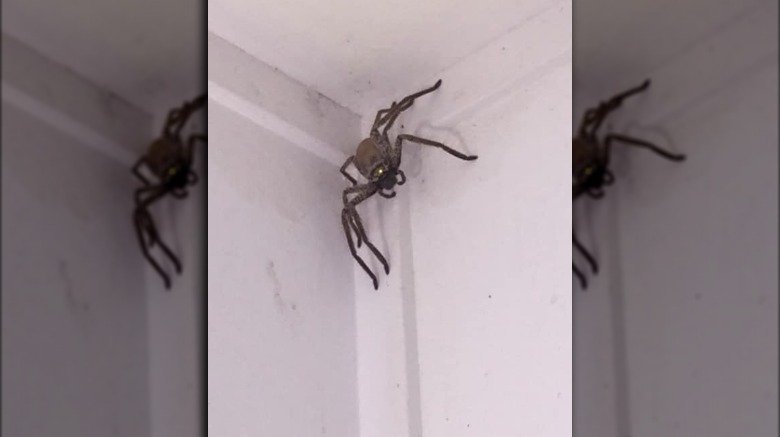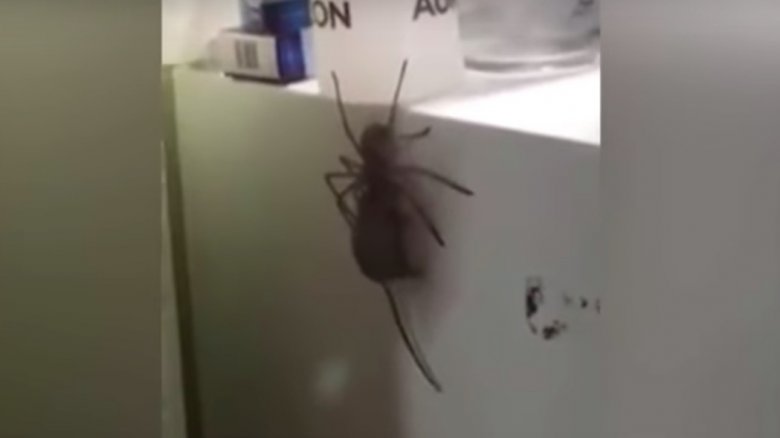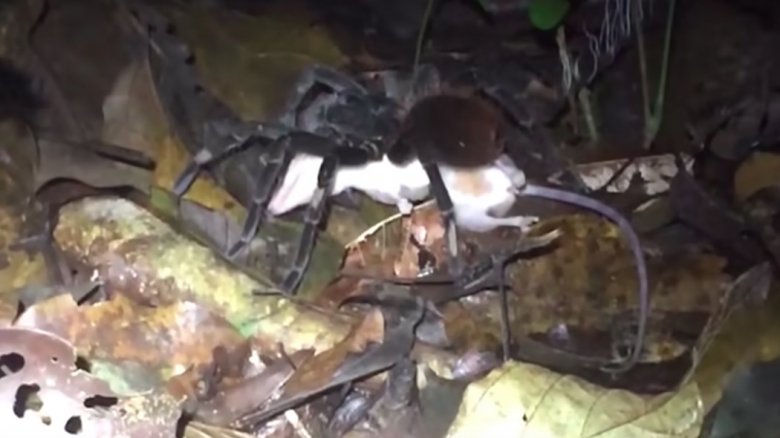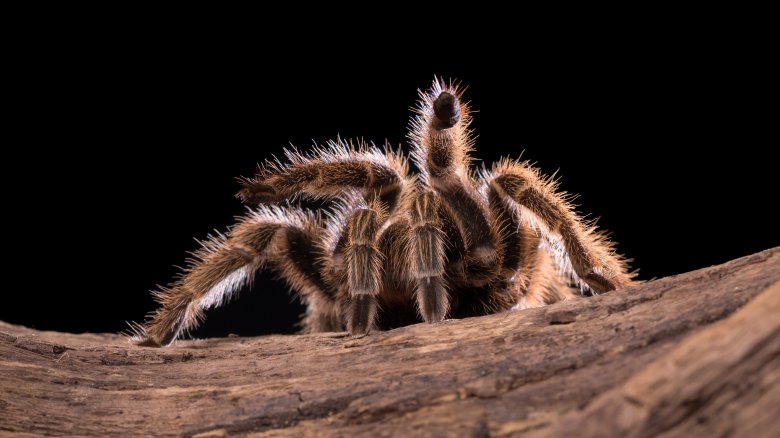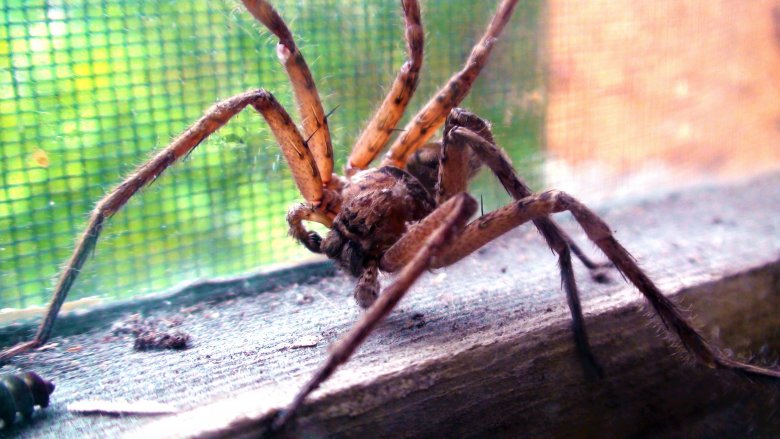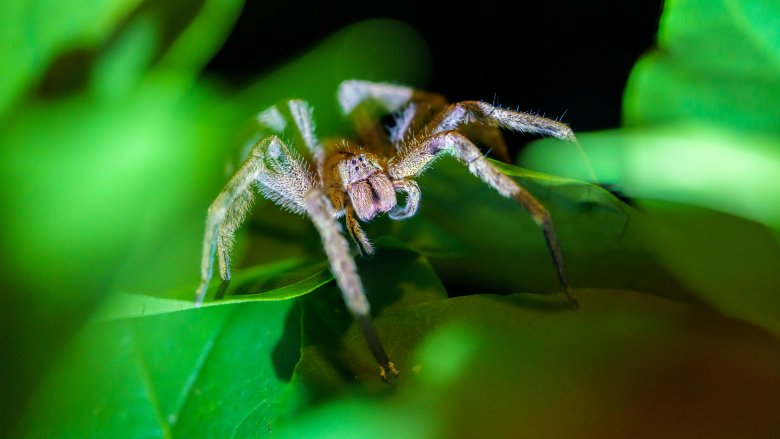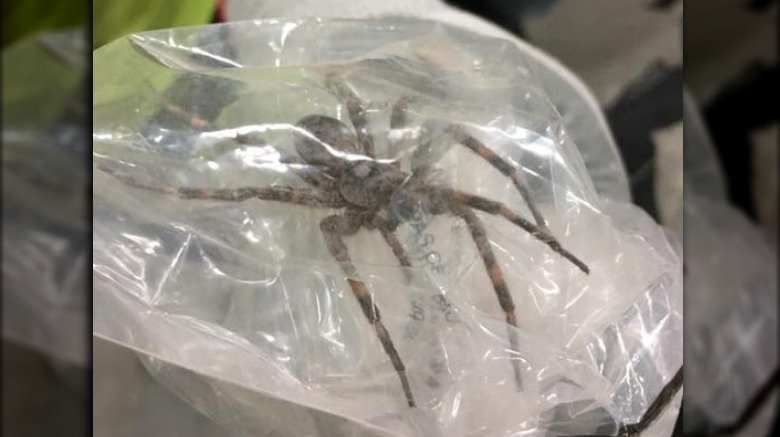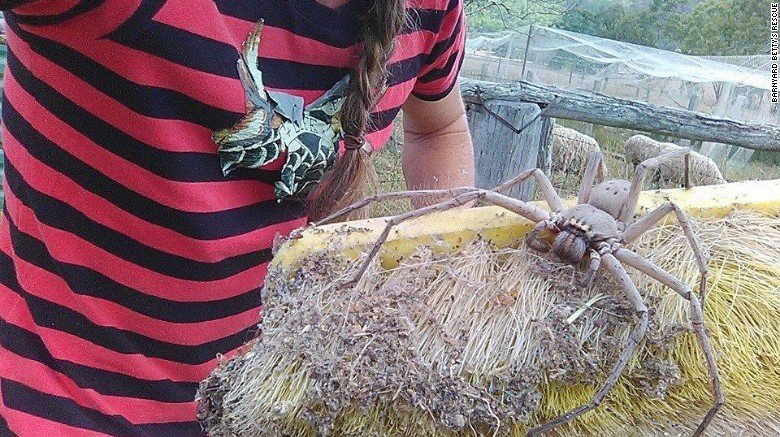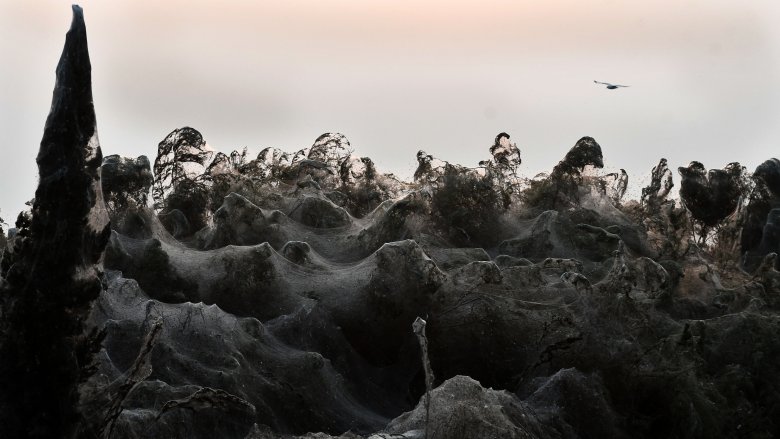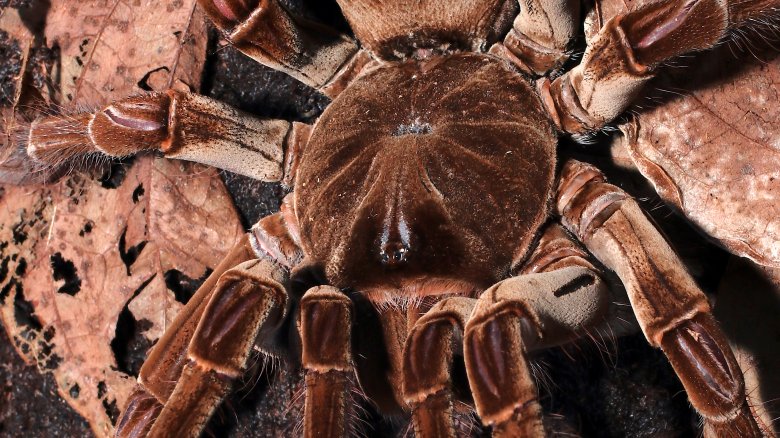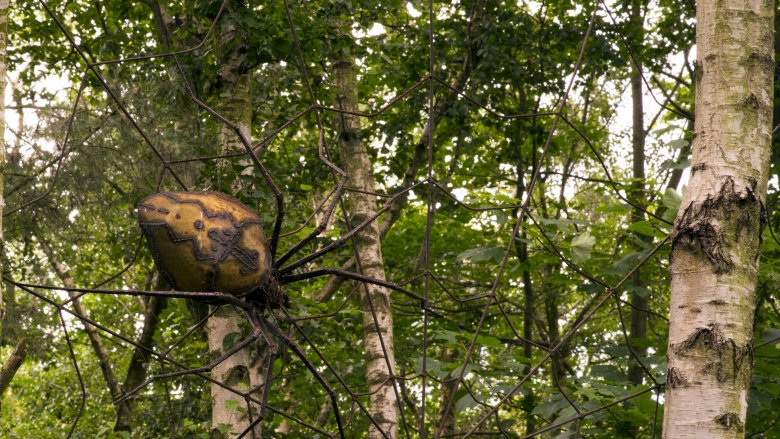Creepy Real-Life Stories About Giant Spiders
Spiders are our friends. It's true! They eat bugs, they probably do other things that are helpful ... actually, there's not really that much to recommend them. Most of them aren't venomous, so we can at least cling to that little shred of hope.
Depending on your own personal feelings about the possibly fuzzy, definitely eight-legged things that somehow keep ending up in your house, the tolerability of any individual spider depends a lot on its size. Small spiders are okay, medium spiders are not as okay, and huge spiders — well, let's just be happy that they mostly just exist in jungles and pet shops. Right? Right??
Well, actually, giant spiders exist all over the world, from the foothills of the Sierra Nevadas to Sri Lanka to Australia, because of course Australia. And when you're the size of a dinner plate, well, it's kind of tough to cram yourself into a dark corner where no one will notice you. So wherever giant spiders share space with human beings, there are bound to be some unpleasant encounters. Here are a few of the worst because hey, who needs to sleep ever again?
This giant spider just decided to move in
If you don't like spiders, you don't have any business living in Australia, visiting Australia, or traveling anywhere within say 400 or 500 miles of Australia because although science has yet to uncover giant spiders that can swim across oceans, you never know. Australia is home to the huntsman spider, called that because it hides out in the woods waiting for Snow White and then it eats her. Hahaha no it doesn't really do that and it's not even venomous, but it doesn't matter. You see, the huntsman isn't content to just stay away; it likes to come into houses.
According to the New York Post, in July 2019 some poor Australian lady returned to her home and found a freaking enormous huntsman spider hanging out in a corner. So she did what any rational person would do, she left a hysterical post on a neighborhood Facebook group: "Is there anyone that could remove this from my house?? Now!???"
To be fair, the spider was only the size of her hand and it only threatened to end her life when she tried to get close to it, so it could have been a lot worse. But the question everyone should be asking is how a spider that size gets into someone's house in the first place. Somewhere in that lady's home is a mighty big hole that needs plugging. Maybe it's time to cement your doors shut.
This giant spider tried to eat a mouse. Yes, a mouse.
They say you shouldn't kill the spiders that live in your house. After all, they're a great way to control the other pests that sometimes get into your house. You know, like mosquitoes, cockroaches, mice ... wait, what?
Yes, some spiders can eat mice, or at least try to eat mice, so rejoice because you're going to save loads on sticky traps, though you'll probably also lose money on sleeping in hotels because you won't ever want to go home again. According to the Guardian, there was a huntsman spider living in an Australian home that caught a mouse and dragged it up the side of a refrigerator. If it makes you feel any better, though, it's likely the spider was just scavenging an already-dead mouse, since even a huge huntsman probably couldn't take on a live mouse.
The two Aussies who witnessed the spectacle seemed not to be very freaked out — they filmed the incident and posted it on YouTube, then later reassured the millions of people who watched the video that the spider was safe and sound. "We have named him Hermie," wrote Jason Wormal, who made the video. "We have adopted him and he is now running his own extermination business out of our town Coppabella. Oh and he is now paying rent."
Nope, that is not funny at all.
This giant spider actually killed an opossum
Some spiders can and do kill vertebrates and because now you desperately want to know about giant spiders killing small furry animals, well, here you go.
In southeastern Peru, there's an enormous dinner plate-sized spider that lives in the jungle and eats opossums. Probably not as a habit, but a video that went viral in March 2019 clearly shows a spider hauling off a small marsupial. Ecologist and evolutionary biologist Dan Rabosky told the Washington Post that large spiders in the Amazon do, in fact, kill vertebrates like frogs, lizards, and opossums (though granted, the opossum in the video was a small "mouse" opossum so it's not like the spider was dragging some cat-sized thing around the forest floor or anything).
Fortunately, the people who encountered the opossum-eating spider were researchers, so none of them freaked out and ran off the edge of a cliff or blundered into some ancient Temple of Doom booby trap or anything like that. They all survived and brought their terrifying video back to civilization so it would haunt the nightmares of arachnophobes all over the world. Thanks.
This guy's pet tarantula flung barbed hairs into his eyeball
Maybe you're one of those people who thinks tarantulas are furry and cute and make great pets. Well, here's some terrible news. Unlike puppies and kittens, tarantulas cannot be brought up to love the ones that feed them. Nope. Because they are not cuddly and they do not care what time you get home from work and they do not like to sit in your lap or chase sticks and they most definitely will not wake you up if there's a fire. In fact, it's pretty safe to say that your pet tarantula does not even like you very much.
Here's proof. In 2010, a 29-year-old British man visited his ophthalmologist complaining of red, painful eyes. His doctor diagnosed pink eye and prescribed medication, but it didn't seem to help. Then, when his doctor viewed his eyeballs under high magnification, he found little hairs sticking out of them.
ABC News says the man finally received a diagnosis when he recalled an encounter with his pet Chilean rose tarantula. He was cleaning the animal's cage when it apparently got defensive and flung barbed hairs into his eyeballs. The barbs worked their way past his cornea and iris and into the back of his eye, where they became impossible to remove surgically. Instead, doctors had to flush them out with steroids. Bet you can't wait to get yourself a pet tarantula now, right?
Little pigs, little pigs, let me come in...
Giant spiders hanging out in corners, giant spiders eating small vertebrates, giant spiders flinging barbed hairs into your eyeballs, well, that's not quite the stuff of horror films. It's close, but it's not exactly "trapped inside your house while a giant spider tries to get inside" or anything.
But oh wait, in yet another story of another giant Australian huntsman spider, these poor people were hanging out in their Queensland home cooking a nice meal when they looked up and saw a giant huntsman spider gazing menacingly at them through their sliding glass door. According to a recap of the social media posts, a standoff followed — the couple tried to scare the beast away and evidently also got their cat involved, but the cat didn't want to have anything to do with the spider because not even cats are that curious.
Anyway, the couple tried to smash the spider with the sliding glass door, which in a horror movie would have totally been that moment when the spider slipped inside and then scurried under a bed or something and then ate the cat and then leapt from its hiding place to drag its human foes into its horrible, horrible web of death. But in real life, the spider — nicknamed Aragog after the one in Harry Potter — was only wounded and ended up retreating into the outside world, where it will no doubt hole up for a couple of days before seeking its revenge. Anyone wanna move to Australia?
Even your local supermarket isn't safe
So far, these are all stories of giant, terrifying spiders that are mostly harmless to humans, besides the part where they can make you so irrational that you might hurt yourself while you run away screaming. But then there was this story that might put you off bananas forever and ever, because it does actually involve a giant spider that also happens to be one of the world's deadliest spiders oh and also, it was in Germany, so not exactly remote jungles or anything.
According to the Huffington Post, an employee who was unloading bananas in a German supermarket saw a large gray spider with a 5-inch leg span "scuttle under a shelf." So instead of trying to catch or kill the thing, he consulted Google so he could learn the identity of the spider that he just set free into a large public food-selling institution. The employee identified the spider as a Brazilian wandering spider, which is one of the world's most venomous spiders.
So then the store had to temporarily shut down while employees tossed all the perishable foods and then fumigated the entire store. They then announced that the spider had been successfully eliminated, even though no one actually ever saw a body. Don't worry, though, if the thing actually got out of the store, the cold German weather probably would have killed it eventually. Probably. Banana, anyone?
This huge "fishing spider" was found by a crew building a boat in ... Indiana
Besides the occasional monstrous wolf spider and desert-dwelling tarantulas, we don't have ginormous spiders in the USA, right? Sorry to burst your poor, delusional bubble, but yes we do. And they don't all live in the desert, either. According to the Indianapolis Star, in the summer of 2018, Jacob Collins was working at an Indiana boatyard when he found a gigantic spider hiding out on the boat he was working on. And then because he just couldn't keep the horror to himself, he took a picture of it and posted it on Facebook with a warning: "Beware all Elkhart residents. They are out there and they are real."
That was kind of fearmongery, so it may comfort you to know that Collins didn't actually know what he was talking about or anything. Sure, the spider was huge (it had a leg span of about 6 inches), but it was actually a harmless fishing spider, which is similar to a wolf spider but typically lives near water. Of course these spiders are actually known to literally walk on water, so that's about as horrible as anything you can imagine.
Okay, let's call Australia a write-off because the spiders are just taking over
This rescue farm probably never intended to rescue this particular sort of creature, but then the danged thing moved in and must have done some mind control crap on all the employees and they all went, "Oh, how cute and sweet let's call it 'Charlotte' and let it stay forever and ever," because there really is no other explanation for their apparent lack of abject terror.
According to CNN, this spider showed up at Betty's Rescue Farm and Sanctuary in (where else) Australia and it's a (what else) huntsman spider that hasn't been officially measured or anything but is definitely on the larger side as far as that particular species goes.
"She was a beautiful, calm spider," the farm wrote on their Facebook page, "not aggressive in any way and like most spiders she just wanted to go about her business eating bugs and living in peace."
And mice. Don't forget mice.
Attack of the cop-eating spider
So far there have been no records of human beings actually getting stalked by giant spiders, and it's true that spiders would prefer to be left alone inside their horrible, horrible webs while they suck the life-force out of small creatures and Frodo. But in the fall of 2018, a dashcam in Fulshear, Texas, appeared to capture some photographic evidence to the contrary. According to the Houston Chronicle, the footage shows a police officer obliviously talking to a motorist during a routine traffic stop while a giant spider creeps up behind him.
Okay so it wasn't really a giant spider, it was a very tiny spider that just happened to be crawling close to the dashcam lens, but the effect was quite uncanny. The seemingly giant spider even paused to clean its front legs before moving in for the kill. Yeah, the kill part of the story was distinctly missing from the video but still, the poor clerk who first viewed the video probably screamed hilariously. If only they had video of that.
Beware spiders in bikinis
Now, imagine going to your favorite lakeside beach for a day in the sun and discovering that overnight it's been turned into giant spider habitat. That definitely sounds like a scene from a horror movie except it wasn't, it was a scene from real life.
According to Time, in September 2018 a beach in Western Greece was covered with more than 900 feet of spider webs. The webs were mostly confined to the plant life, but still, there probably aren't many people who would be into tiptoeing barefoot around that stuff on their way to the water's edge.
The giant spiders, of course, were lurking inside the webs, waiting until dusk to come out and nab the tourists who stuck around for the sunset. Just kidding. The spiders that made that 900 feet of web weren't even large, they were tetragnatha spiders, which only grow to be about a little less than an inch wide. In fact, local scientists seemed to suggest that residents ought to actually welcome the spiders, which are probably there because of a rise in the mosquito population. So be grateful, and maybe vacation in Antarctica this year instead.
A puppy-sized spider. Enough said.
Okay, let's say you're looking for a nice, exotic, warm weather locale for your next vacation. How about South America? Nope. You need to stay away from South American jungles, Greek beaches, and Australia and you need to move into a steel-reinforced compound in Antarctica where they will never find you.
Anyway, once upon a time, according to LiveScience, there was a guy taking a stroll in the rain forest of Guyana. At night. He heard rustling beneath his feet and instead of running away like any sensible person would, he shone his flashlight on it the rustling and saw a "puppy-sized spider" of the species Theraphosa blondi, otherwise known as the South American Goliath birdeater.
Okay, so "puppy-sized" is subjective. Are we talking chihuahua or bull mastiff? Or something in between, like a golden retriever? Well the guy who encountered this spider (who also happened to be an entomologist, which explains why he didn't run blindly into a Temple of Doom booby trap) said that Goliath birdeaters can have a leg span of about 12 inches and can weigh up to 6 ounces, which is actually a lot smaller by weight than even a very small puppy, but roughly the same size by leg span as an adult French bulldog, if the French bulldog were doing some weird flat contortion-y thing. So let's just add the rain forest of Guyana onto our list of places you should never go.
A real-life Shelob (not really, but maybe)
This is only a story and is almost 100% guaranteed to be not true. Almost. But it's worth thinking about because for centuries the native people of the Congo have been saying that there's a giant spider living deep within the rain forest. And we're not just talking Goliath birdeater giant, either, we're talking Shelob giant. You know, the spider that lived in the mountains of Mordor and tried to eat Frodo.
This particular sort of spider is called J'ba Fofi, and it supposedly makes huge webs on the forest floor deep in the unexplored jungles of Central Africa. While Goliath birdeaters have a mere 12 inch leg span, J'ba Fofi is reputed to be 4 or 5 feet across, which definitely puts it in the Shelob category, and most definitely puts them in the "flee into a Temple of Doom booby trap" category.
According to the Reluctant Skeptic, there are at least a handful of non-native people who claim to have actually seen J'ba Fofi, including a missionary in the 1890s who said his two porters were attacked by one, and an English explorer in 1938 who said one crossed his path while he was traveling through the Congo. Now, stories about J'ba Fofi are almost definitely just folk tales, but why risk it?
